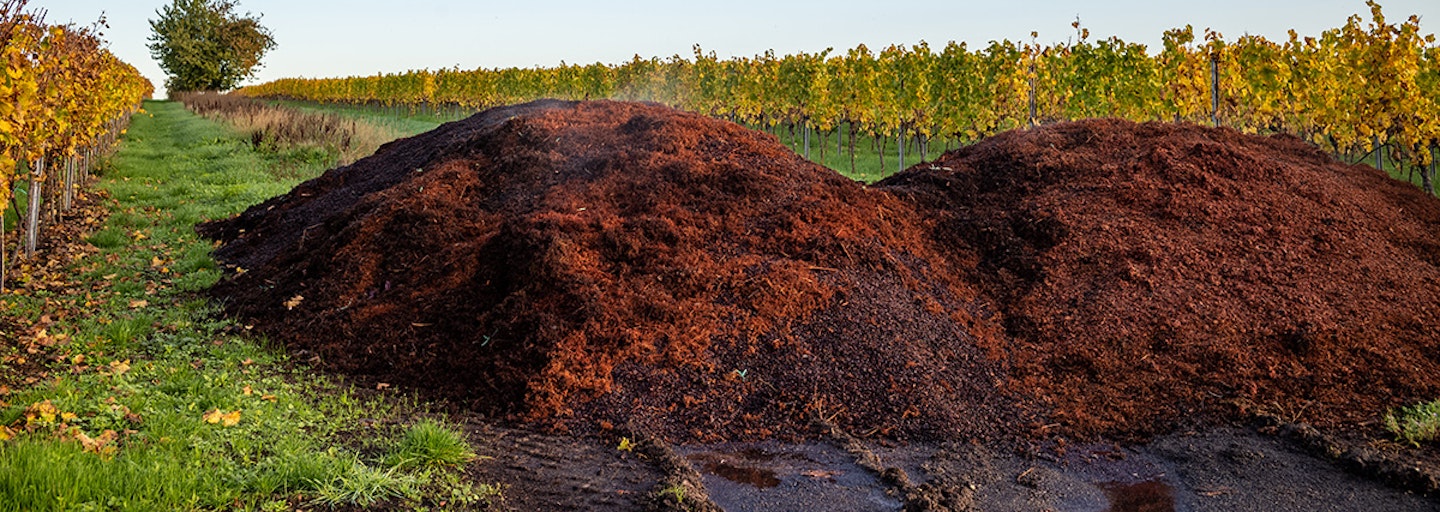The sustainability benefits of using grape marc as compost
Grape marc, a byproduct of winemaking, is often seen as waste. By blending it into a growing media, vineyards eliminate the need for disposal, reducing waste and its associated environmental impact.
Disposing of grape marc poses challenges due to potential leachates contaminating soils and waterways and the immense volume produced all at once. This makes dumping or uncontrolled decomposition unsustainable. So finding a viable solution for the tons of grape marc waste generated each harvest becomes a collective interest.
Azwood recommends repurposing grape marc by blending with a composted media to create a cost effective and sustainable soil conditioner. Instead of discarding it outright, vineyards can harness its nutrients, transforming it into a valuable resource for enriching the soil and nurturing vine growth.
By embracing the soil conditioner blending process, as a means to repurpose grape marc, the winemaking industry can progress toward a more sustainable waste management approach. This shift not only reduces waste but also enables the winemaking industry to create its own circular economy, where what was once deemed waste becomes an asset.
Creating a circular economy
Blending grape marc into a pre-composted organic media, promotes a circular economy within vineyard operations, reducing waste while enhancing sustainability and environmental stewardship.
What was once considered waste becomes a valuable resource for enhancing soil health, supporting plant growth, and ultimately contributing to the quality of the wine produced.
Not only are vineyards creating their own circular economy by repurposing their waste and putting it back in the earth, by partnering with Azwood for blending medias they are supporting cross industry circular economies as well.
Azwood has structured its business around a circular economy by giving local businesses in many industries a way to sustainably repurpose their waste where we then create a range of natural medias including compost, potting mixes and mulches.
Whilst Azwood cannot feasibly take on the shear mass of grape marc that is produced each harvest season, we have found a solution that supports sustainable winegrowing and aligns with the principles of a circular economy by maximizing resource efficiency, minimizing waste, and contributing to a more sustainable and resilient vineyard ecosystem.
We support vineyards by supplying a blending media for them to create a nutritious compost mix that dilutes the grape marc properties making it perfect for immediate spreading back onto the vineyard.
Blending grape marc is a solution for
- 01
Disposal
Rather than resorting to conventional disposal methods, which can be costly and have negative environmental repercussions, blending grape marc with a composted organic media within the vineyard can lead to cost savings in waste management. Furthermore it can potentially reduce the need for synthetic fertilisers or soil amendments, improving operational efficiency and contributing to sustainable winegrowing practices.
- 02
Soil health
Creating a blended grape marc compost and applying it to your vineyard opens up the soils and enhances soil structure. The compost derived from this blend helps create soil aggregates, improving soil porosity and aeration, providing greater organic matter and soil biology. This improved structure encourages root growth and facilitates nutrient absorption by the vines. The improved soil structure also helps prevent erosion by holding soil particles together. Additionally, it enhances water retention capacity, reducing the need for frequent irrigation and aiding in drought resistance for the plants during the drier months.
- 03
Organic matter
Grape marc is rich in organic matter and contains essential nutrients like nitrogen, potassium, and phosphorus. Another reason why this untapped resource should be utilised by vineyards to put these nutrients back into the soil. The abundance of organic matter within grape marc not only offers a reservoir of key nutrients but also plays a pivotal role in nurturing soil microorganisms. As the soil microorganisms thrive, they contribute to the breakdown of organic matter, releasing nutrients gradually and steadily, thereby sustaining the vineyard's growth cycle.
Nitrogen levels
Nitrogen, a vital nutrient for plant growth, is prone to leaching when applied directly in large amounts which is why there are significant restrictions on applying grape marc directly to your vineyard.
Blending grape marc, however, allows for the stabilization of nitrogen within the organic matter. Once the grape marc is blended and applied to your vineyard, the composting process occurs, where the nitrogen in grape marc, being evenly blended throughout the soil conditioner, creates a more stable organic media, reducing the risk of quick release and leaching.
The breakdown of organic matter in grape marc compost occurs gradually. This slow decomposition process means that the nitrogen within the compost is released slowly and steadily over time. As a result, vineyard plants receive a sustained and balanced supply of nitrogen, matching their uptake needs without overwhelming the soil.
The grape marc/soil conditioner blend ensures minimal nitrogen drawdown form the vineyard soils; and a steady release of nitrogen and other nutrients such as potassium and phosphorus, providing a sustained supply to the vines and reduces the risk of nitrogen leaching which can become an issue if applied directly.
Lets talk
Ask us how you can repurpose your vineyards grape marc this harvest.
Get in touchRelated articles

Follow us
More from Azwood
Connect with us on social media to learn more and be the first to hear our latest industry updates

